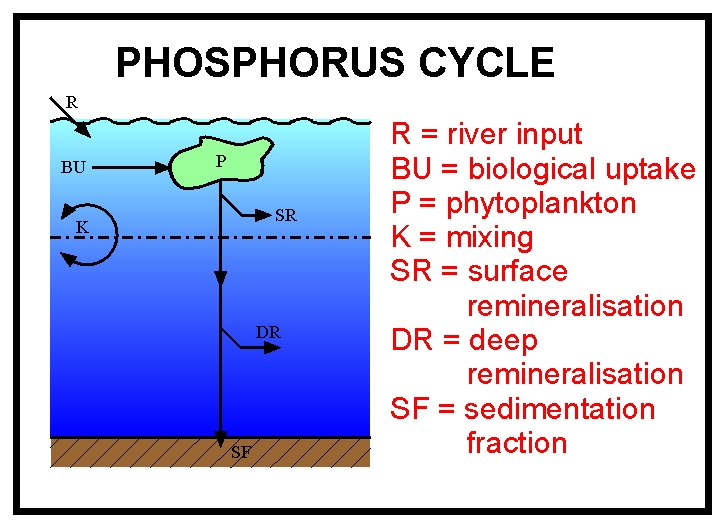
The phosphorus model consists of a first-order description of the major source and sink terms in the ocean's phosphorus cycle, including those fluxes most relevant to control of phytoplankton growth in the sea.
Overview
The phosphorus model is a highly simplified representation of the ocean's biogeochemical cycle of phosphorus. It is the simplest form that is able to reproduce the essential aspects of how atoms of phosphorus enter the ocean, are transported about within it, and then finally leave the ocean. A key aspect of the model is its representation of how phosphorus is utilised (taken up and released) by the ocean's biological communities. The main aim of the model is to examine how the amount of phosphorus in the oceans is controlled over long (typically geological) timescales
The diagram to the right shows how the oceanic cycle of phosphorus is represented in the model. The model is a two box model of the global ocean. The upper box represents the surface ocean from the euphotic zone down to the limit of the deepest wind-induced mixing during the year, while the lower box represents the deep ocean below the influence of wind and waves.
The largest fluxes (transports) of phosphorus are included in the model. Phosphorus is almost totally absent from the atmosphere, and the only significant input of phosphorus to the ocean is that from the flow of water down rivers. Various chemicals are dissolved in river water (it isn't completely pure) and one of those chemicals is phosphorus. The most significant loss of phosphorus from the oceans is as organic debris (remains of living organisms) sinking to the ocean floor and becoming incorporated into sedimentary rocks. As well as these inputs to and outputs from the ocean as a whole, the model also includes the main processes that shift phosphorus between surface and deep waters within the oceans. These are:
1. Uptake of dissolved phosphate to form new phytoplankton (i.e. plant) biomass;
2. Subsequent release (after cells get attacked by bacteria or predators, or after cells break apart for other reasons) of most of this organic phosphorus back into dissolved nutrients in the surface ocean;
3. Release of a further portion of the organic phosphorus back into deeper waters after small particles of organic material sink out of the surface oceans and are then are decomposed by deeper-dwelling bacteria; and
4. Slow mixing between the surface and deep oceans, partly due to the physical movement of large masses of water between the surface and deep layers (upwelling and downwelling), and partly due to diffusion.
Click here for a more detailed description of the phosphorus model.
Further Infomation
Phosphorus model overview
Phosphorus model details
Phosphorus model cons
Phosphorus model pros
Phosphorus model help
Phosphorus model worksheet
Refrences
Tyrrell, T. (1999). The relative influences of nitrogen and phosphorus on oceanic primary production. Nature 400, 525–531.
External Links
Description of the chemical element phosphorus
Description of the phosphorus cycle